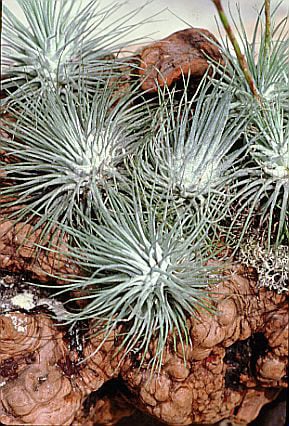Tillandsia argentea
silver-leaved air plant
An evergreen, epiphytic perennial forming rosettes to 25cm across, with linear to narrowly triangular leaves covered with silvery-white scales and, in spring, spikes of tubular red or blue flowers with pink bracts

Buy this plant
Size
Ultimate height
0.1–0.5 metresTime to ultimate height
5–10 yearsUltimate spread
0.1–0.5 metresGrowing conditions
Moisture
Well–drainedpH
NeutralColour & scent
| Stem | Flower | Foliage | Fruit | |
| Spring | Green Grey Silver | |||
|---|---|---|---|---|
| Summer | Green Grey Silver | |||
| Autumn | Green Grey Silver | |||
| Winter | Green Grey Silver |
Position
- Partial shade
Aspect
West–facing or East–facing
Exposure
Sheltered Hardiness
H1CBotanical details
- Family
- Bromeliaceae
- Native to GB / Ireland
- No
- Foliage
- Evergreen
- Habit
- Tufted
- Genus
Tillandsia are evergreen perennials, often epiphytic, forming rosettes of leathery, linear or strap-shaped leaves, and tubular or funnel-shaped flowers which may be 2-ranked in spikes with conspicuous bracts, or solitary and inconspicuous
- Name status
Unresolved
How to grow
Cultivation
Plants need no compost; they are glued or wired to a support. Grow under glass in bright but diffused light with good ventilation. From spring to autumn immerse in rainwater twice a week (more in hot, dry conditions), drain well and allow to dry. Can stand outside in summer to benefit from rain, additional light and humidity. See Air plants for further information
Propagation
Propagate from seed (see Air plants) or by separating offsets once they are at least a third the size of the parent.
Suggested planting locations and garden types
- Patio and container plants
- Sub-tropical
Pruning
Remove individual rosettes that have died after flowering
Pests
Diseases
Generally disease-free
Get involved
The Royal Horticultural Society is the UK’s leading gardening charity. We aim to enrich everyone’s life through plants, and make the UK a greener and more beautiful place.